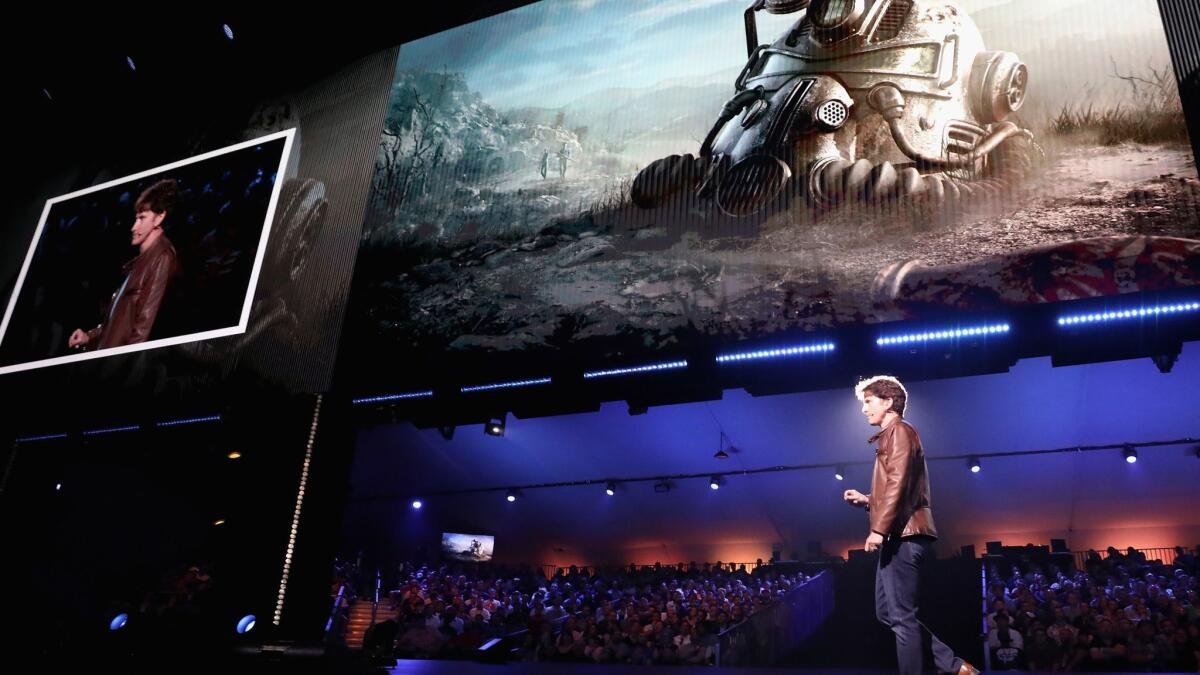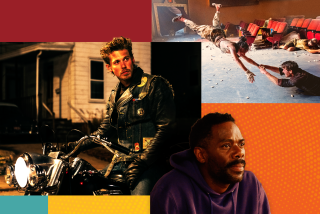Surviving as a single-player in video game’s multiplayer world
- Share via
When the Electronic Entertainment Expo took over downtown Los Angeles last week, there was talk of new technologies as well as hints of a “next generation” of consoles. Yet the most striking moment during the weeklong celebration of gaming was something far more simple: a kiss.
An unexpectedly intimate and warmly optimistic scene — one complete with honest and awkward dialogue — launched Sony’s presentation of “The Last of Us Part 2.” The scene of a kiss between two women made the argument that good ol’ fashioned storytelling still tops slick gameplay and larger-than-life digital effects
At E3, “The Last of Us Part 2” was an outlier, and not just because it emphasized teen romance — and, to be sure, lots of intense violence. “The Last of Us Part 2” stands out as a single-player game in an increasingly multiplayer world. Big-budget games today are going communal. And with Epic Games recently unveiling that more than 125 million people have played “Fortnite,” who can blame them?
A longstanding single-player franchise such as “Fallout” announced its upcoming “Fallout 76” would be a multiplayer experience. BioWare, known best for single-player narratives such as “Dragon Age” and “Mass Affect,” is embracing social with its upcoming shooter “Anthem.” Treyarch stated that its newest “Call of Duty” title would go without a single-player campaign.
Other games, such as Rare’s pirate adventure “Sea of Thieves” for Xbox One, is geared toward social play, to the point that its single-player experience is barely playable. Ubisoft’s own upcoming pirate title, “Skull and Bones,” is also going the multiplayer route, and last year, Electronic Arts shuttered a “Star Wars” title from celebrated game storyteller Amy Hennig of “Uncharted” fame to “pivot” away from “a story-based, linear adventure game.”
Which leads to this question: What’s the future for the introverted player, the one who doesn’t want to game with strangers and whose friends don’t have the latest consoles? Are those of us who want to dig in with a game in the solitary way we devour a book or binge watch a series slowly being phased out?
“That conversation is scary,” said Naughty Dog’s Neil Druckmann, currently overseeing production of “The Last of Us Part 2. “It’s scary because those are my favorite kinds of games, and if there’s fewer people making those games? That’s one of the reasons I joined the industry.”
The kiss in “The Last of Us Part 2” was effective because it felt directed — that is, it was carefully written and staged by artists who want players to discover a rather specific story. Such is a key benefit of the single-player experience. Co-writer of the game Halley Gross said “The Last of Us Part 2” provided her an opportunity to go deep on the lasting effects of trauma, especially as it pertains to a young woman.
“It is this hostile environment; it is this place where there are no rules,” she said. “When you have to fight for your life everyday, and you can’t go to therapy and you can’t get help, how do you deal with that and how does that corrupt you? Or save you?”
There are benefits to the single-player games beyond just thoughtful character development and a heavy narrative focus. Combat and action can feel more personally choreographed in ways that fit the story. In “The Last of Us Part 2,” fight scenes feel claustrophobic.
In FromSoftware’s “Sekiro: Shadows Die Twice,” set in a fantastical take on feudal Japan, the studio’s marketing manager, Yasuhiro Kitao, said via a translator that adding options for another player would essentially mean having to create more generic enemies that could be scaled to multiple skill-sets at once.
In a game such as “Fortnite,” chaos and humor rule. The wild anything-goes matches result in a vastly unpredictable game where spontaneity and competition matter significantly more than story. That’s expected, as the game must be designed to support the whims of dozens of strangers.
Multiplayer inherently changes the tone of a game, one that can give it more of a sport-like feel.
“Speaking personally, and ensuring I’ll never work again, I’m a single-player story guy,” said veteran developer Warren Spector (“Epic Mickey,” “Deus Ex”). “I think interactive storytelling is really fascinating. Virtual socializing is less interesting to me than establishing a connection with a game. For me, games are a dialogue between the developer and the player, and not necessarily 16 players out there in the world.”
What’s changing, however, is the quest by developers to bring narrative-rich experiences into the multiplayer universe. A franchise such as “Destiny” is designed essentially to last forever, creating an immersive universe rather than a beginning-middle-end. This solves one inherent problem of a single-player game: People purchase it once and then stop spending money.
BioWare’s sci-fi space gunner “Anthem” looks to go after a similar market, as it’s emphasizing cooperative gameplay in a setting in which missions could be added over a number of years. In theory, this allows developers to create multiple revenue streams for a single game, either via micro-transitions, subscriptions or world-building expansion packs.
The challenges: making the narrative feel more guided and controlled than so-called environmental storytelling usually allows and trying to ensure that everyone plays along nicely. Though my time with the game at E3 was limited, I was often using my jetpack to soar among the forest-like planet in the opposite (read: wrong) direction of everyone else on my team.
BioWare’s general manager, Casey Hudson, tried to assuage my concern, saying that the game would be friendly. “Anthem,” he said, will encourage mentor-mentee relationships.
“Anyone can play with any level, and when you’re a higher level, there are bonuses for playing with people who are at a lower level and helping them out,” he said. “It’s a mentor system, including helping people through the first levels of the game.”
When the topic of single-player games entering endangered species status comes up, most every developer — including the industry’s own trade body, the Electronic Software Assn. — says a variation of the same thing: Look at Bethesda. The studio last year launched a slightly tongue-in-cheek campaign dubbed “Save Player 1,” noting that while gaming is “often about social interaction,” sometimes one needs some personal space.
Yet Bethesda this year took the single-player-focused “Fallout” series and turned it into a multiplayer experience with the upcoming “Fallout 76.”
“The stuff we’ve traditionally done, it’s good to say, ‘You’re the hero, the world is here for you and we’ve designed it all around maximizing your personal experience. We’re the dungeon master. Trust us,’” said Bethesda executive and “Fallout” architect Todd Howard, who added that even in traditionally single-player games, the studio has been thinking of ways to facilitate more interaction among friends, even if it’s as simple as sharing a photo.
Yet in “Fallout 76,” every human in the game will be controlled by another human. Traditionally, in the game’s violent post-apocalyptic world, even the non-player-controlled characters are regularly despicable. Won’t turning their digital brains over to humans simply create a more inhospitable, anarchic experience?

Howard said Bethesda is thinking hard about preventing strangers from ruining someone’s game in “Fallout 76.” Don’t, he said, expect to see my digital character just randomly shot in the head by some unseen foe.
“That’s very hard for them to do,” he said. “They offer you a challenge. It’s like if someone walks up to you into a bar and slaps you. ‘Do you want to fight?’ You can be like, ‘That’s kind of annoying. I’m just going to walk away.’ That’s the vibe we want.
“We want to incentive it,” Howard continued. “Imagine the guy slaps you, and then someone walks up to you and says, ‘I’ll give you $1,000 if you fight that guy.’ The game incentives you to fight. It’s the same way we would design an entertaining encounter, but [we’re having] the game design give the player those tools to design those entertaining encounters themselves.”
Right.
But what if I still trust, say, Howard to give me the best experience rather than strangers I encounter in a virtual world? For example, after the reaction to “Star Wars: The Last Jedi,” I shudder at what any “Star Wars” fan would do if given Lucasfilm’s tools.
If I long ago decided “World of Warcraft” wasn’t my style of gaming, shouldn’t today’s multiplayer obsession frighten me? When it comes to big budget mainstream games, that answer remains unclear. “This is not some flag that says, ‘This is the future of everything,’” said Howard, trying to reassure me.
But even Spector, that self-described “single-player story guy,” said multiplayer offers some irresistible problems designers have yet to solve, and I should expect plenty in the years ahead to give it their best shot.
“I’ve spent my entire career trying to re-create the feeling I got when I played ‘Dungeons & Dragons’ with my friends, where there was six of us telling stories with each other,” he said. “It’s a really interesting problem. How do you take an electronic game and let six players tell a story to each other? From an intellectual standpoint, I find that really interesting. I find that kind of cooperative storytelling a really interesting challenge, and I’d like to tackle that someday.
“I’m a single-player story guy not so much because I’m a single-player guy,” he added, “but because I’m a story guy.”
And for now, I want my stories dictated by storytellers and not my niece and nephew who just got a new game console.
Follow me on Twitter: @toddmartens
More to Read
The biggest entertainment stories
Get our big stories about Hollywood, film, television, music, arts, culture and more right in your inbox as soon as they publish.
You may occasionally receive promotional content from the Los Angeles Times.











